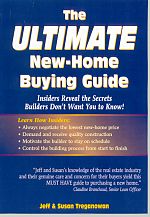|
|
 |
Your New House
By Denise and Alan Fields
 FOUR TRUTHS ABOUT BUYING A NEW HOME NO ONE TELLS YOU. FOUR TRUTHS ABOUT BUYING A NEW HOME NO ONE TELLS YOU.
- 1. Bob Vila is not building your home. You’ve seen those TV shows like “This Old House,” where Bob,
Norm or Steve and a crew of careful craftsmen lovingly restore a home. The workers ruminate endlessly about the correct way
to install this door or that siding. Many homebuyers think they are getting this level of care when they build or buy a new
home. And why not? It’s not like builders are giving them away. Sorry, folks, this type of skilled building is seen
only on television. Real life means building crews who are more like Larry, Curly, and Moe—bumbling idiots who couldn’t
tell their butt from a two-by-four. The only thing these guys ruminate on endlessly is which bar they’ll hit at quitting
time. One homebuyer we interviewed said she was shocked at the level of workmanship on her $300,000 semi-custom home. Sloppy
carpentry, lousy cabinet installation, incompetent roofers—the buyer was amazed at what a “new” home actually
means in today’s marketplace. This is the ultimate reality check on building a new home: Bob Vila is not your builder.
As a result, you need to protect yourself. That’s the goal of this book: we’ll tell you exactly how you can do
this and get the best deal for the dollar.
- 2. You get to pay for all those wonderful advancements of science. Building a home at the dawn of the 21st Century is
a quick lesson in environmental “correctness.” Water-saving toilets, extra insulation, super-efficient furnaces
are now required by law in many communities—and who do you think pays for all this? You, in the form of higher home
prices. Sure, some of this stuff may pay dividends down the line (in lower utility bills), but you still have to pay for all
these expensive toys today. Stringent environmental laws translate into tougher building standards and limited supply of certain
materials. And when the supply goes down, it’s you that’s left holding the bag. When you decide to build a new
home, you enter the mysterious world of Lumber Shortages, Drywall Rationing and other strange market conditions caused by
hurricanes that strike Indonesia.
The result: a home built today may be more “politically correct” than one
built in 1969—but you get to pay for the privilege.
For all the gory details, check out the charts later in this
chapter that list the "average" costs of building a new home today.
- It always takes more time, money and patience than the original estimate. So, your builder says he can build you a $315,000
home in just four months? Six months later, you’re pulling your hair out because that home is now $360,000 and isn’t
even finished yet. The percentage of homes finished on time and on budget must be small enough to fit on the head of a pin.
Nearly every homebuyer we’ve interviewed across the country recounts a similar story—it cost more and took longer
than they anticipated. Recognizing this at the outset is the best course. In the following chapters, we’ll give you
specific suggestions for minimizing the pain.
- “New construction” does not mean “soundly constructed.” High price does not mean high quality.
In the bizarre world of new homes, “new” doesn’t have the same meaning as other “new” products,
like a new car. A new home means only that no one has lived there yet—and that’s a plus and a minus. “New”
does not mean the house was soundly constructed. A quickly slapped-up tract house with the cheapest of cheap materials may
be “new,” but it could cause years of headaches.
And just because you’re spending a lot of money does
not mean you’re getting commensurate quality. A $300,000 house may be loaded with cheap windows, a lousy paint job and
poor roofing—if you don’t pay attention, you might get a house that’s really worth much less than you’re
paying . . . especially if you’re stuck with repair bills and costly maintenance.
Some builders seem keenly aware
that most of their customers have no clue when it comes to differentiating quality from shoddy construction. Ray Redden, president
of Redden Properties, an Atlanta, Georgia builder said in a recent issue of Builder magazine, “Most home buyer’s
perception of quality starts (and finishes) with how much molding there is in the house.” And sadly, there is a ring
of truth to that insulting statement. The best solution to protect yourself from shoddy construction is to arm yourself with
knowledge. While you can’t become a genius in construction overnight, you can surround yourself with experts who won’t
be fooled by a shoddy house that’s disguised with pretty molding. More on this strategy later.

"The Ultimate New-Home Buying Guide"
By Jeff & Susan Treganowan
Price is $15.95 plus Shipping and Handling ($3.50)
To order by phone call: 1-800-266-5564
To order online, go to: http://www.Mapleleafpress.com
Investigating Your Builder
Check your builder's license status with the CSLB-
California- Contractors State Licensing Board.
NOTE: The CSLB does not disclose pending and/or past criminal and or civil
legal actions, only board related legal actions.
Check your county court house to see if your builder has been involved in any contractor related legal
actions. Check out Criminal records also, for your family's safety. One Home Builder with
a clean BBB record and license status was found to have 587 Construction Defect related lawsuits!
Contact your local BBB to obtain a report on your contractor.
Talk with past costumers.
|
|
|
|
|
|
|
 |
|



